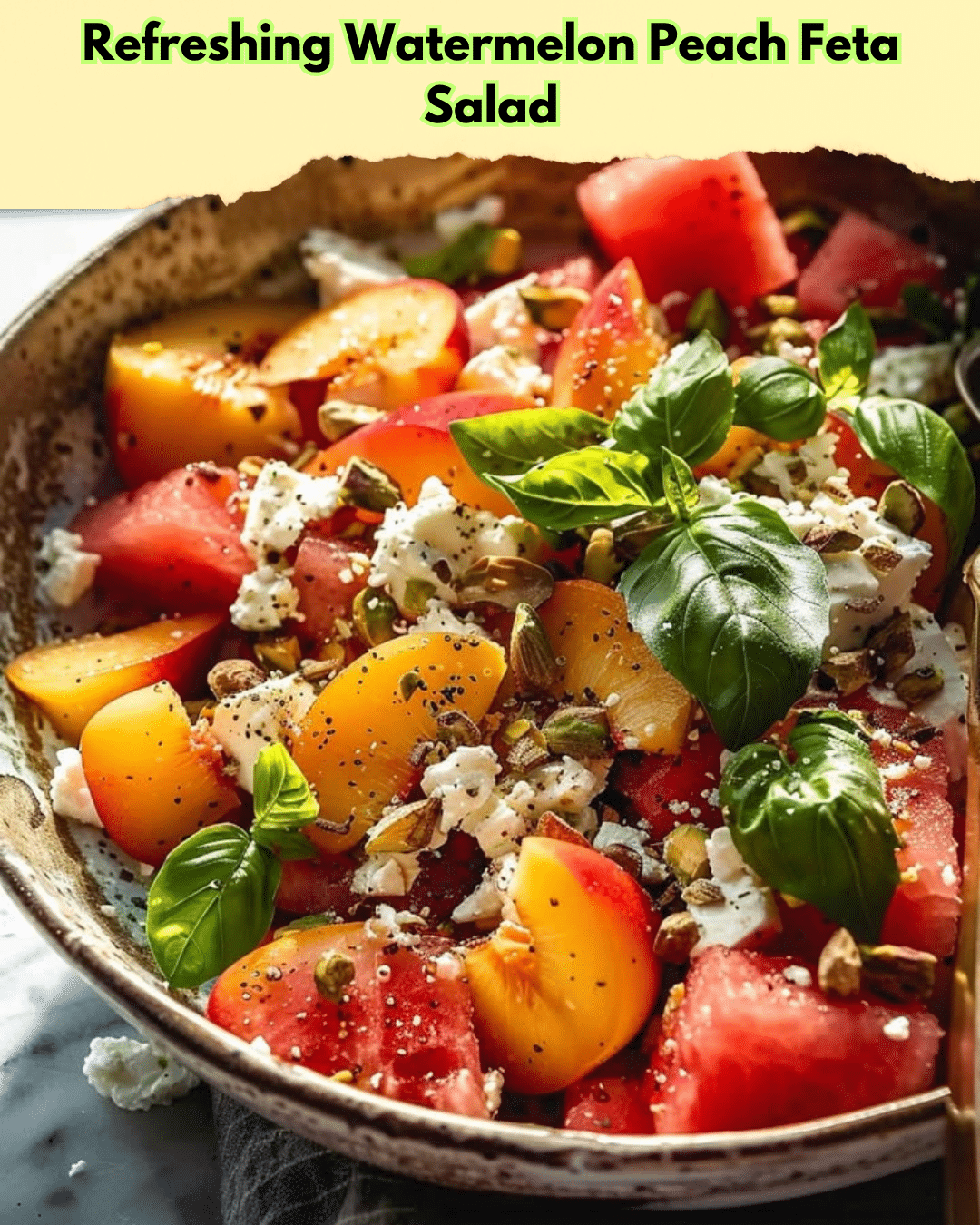Refreshing Watermelon Peach Feta Salad: A Summertime Delight
The blend of flavors in this Watermelon Peach Feta Salad is heavenly. The juicy sweetness of watermelon pairs beautifully with the delicate tang of peaches, while the salty feta balances the fruits’ sweetness with umami richness. Add in a hint of mint for freshness and a drizzle of balsamic glaze for depth, and you’ve got a flavor profile that teases every sense. It’s the kind of dish that can transform a regular day into something extraordinary.
This salad is more than just a delightful combination of fruits and cheese; it embodies the essence of summertime bliss. Whether you’re hosting a gathering or simply enjoying a quiet meal on your patio, the Watermelon Peach Feta Salad invites you to indulge in the simple pleasures of fresh, wholesome ingredients.
Quick Recipe Highlights
- Flavor Profile: The salad combines sweet, juicy watermelon and peaches with salty feta and refreshing mint, culminating in a tantalizing taste journey.
- Texture: With the crisp bite of watermelon, the softness of peaches, and the crumbly texture of feta, every forkful offers a delightful variety of textures.
- Aroma: You’ll be enveloped by the fruity fragrance of fresh peaches and watermelon, complemented by mint’s cooling scent.
- Visual Appeal: The vivid contrast of pink watermelon, orange peaches, and white feta against a green mint backdrop creates a stunning, photogenic dish.
- Skill Level Needed: Perfect for beginners, this salad requires basic slicing skills and the ability to assemble ingredients thoughtfully.
- Special Equipment: Simply fresh ingredients, a sharp knife, and a large serving bowl make this a no-fuss, minimal-equipment recipe.
Recipe Overview
- Difficulty Level: Easy – This simple recipe involves minimal preparation, which is great for anyone looking for a quick and delicious dish.
- Category: Salad – This dish thrives as either a side salad or a light main meal, adaptable enough for any menu planning.
- Cuisine: This salad draws influence from Mediterranean flavors with its use of feta, fresh fruits, and balsamic glaze, offering a luxurious yet accessible touch.
- Cost: Affordable, as the star ingredients are typically inexpensive, especially when bought in season.
- Season: Best during summer, maximizing the natural sweetness of watermelon and peaches when they’re at their peak.
- Occasion: Perfect for picnics, summer gatherings, or even as a refreshing starter for a dinner party.
Why You’ll Love This Recipe
This Watermelon Peach Feta Salad delivers in taste and texture, providing a harmonious blend of sweet and savory that lingers lovingly on the palate. The juicy watermelon bursts with flavor, complemented by the sweetness of ripe peaches and the sharp tang of crumbled feta cheese. Each bite brings a new experience – a hint of mint here, a dash of balsamic vinegar there – creating a dish that’s as varied as it is enjoyable.
Convenience is a central theme with this salad, requiring only twenty minutes from start to finish. A minimal ingredient list demands only dicing and assembling, making it perfect for quick meals or last-minute entertaining. Despite its simplicity, the dish exudes an elegance that elevates any mealtime setting.
Nutritionally, this salad is a powerhouse. Watermelon and peaches are low-calorie, hydrating fruits loaded with vitamins A and C, while feta adds protein and calcium. The mint not only enhances the cooling sensation but also aids in digestion, making it the perfect choice for health-conscious diners.
Beyond its solo appeal, this salad acts as a fantastic social centerpiece. Its vibrant colors and inviting aroma make it a conversation starter, whether shared at a barbecue or a cozy family dinner. It’s the kind of dish that encourages guests to linger, savor, and request seconds.
Cost-effectiveness and accessibility are also key highlights. Budget-friendly ingredients become gourmet fare with just a few simple touches, allowing anyone to charm friends and family without breaking the bank. The results: a stunning, delicious salad that’s as kind to your wallet as it is delightful to your guests.
Historical Background and Cultural Significance
The origin story of the Watermelon Peach Feta Salad is a testament to the creativity of home cooks inspired by the bounty of summer produce. While watermelon and feta salads have Greek roots, the addition of peaches elevates this dish to new heights, borrowing elements from diverse culinary traditions.
In the Mediterranean, combining fruit with cheese and herbs is a time-honored tradition, where the balance of sweet and savory is artfully achieved. This salad modernizes that authentic practice by introducing peaches, adding a Southern US twist to a classic idea and illustrating culinary globalization at its finest.
Evolving over time, the recipe has seen various adaptations. Originally, watermelon salads with feta sprinkles were simple, but creative cooks have introduced things like balsamic reductions and toasted nuts, enhancing the complexity while staying true to classical flavors.
Regional variations abound, from Italian-inspired versions with basil to Middle Eastern editions featuring grilled peaches. Each adaptation preserves the core essence of sweet fruit mingling with savory cheese, showcasing the flexibility and universal appeal of this delightful dish.
Ingredient Deep Dive
Watermelon stands as the star ingredient, offering more than just flavor; it provides a refreshing burst of hydration and is rich in antioxidants such as lycopene. Originating from Africa, the fruit spread across the world, cementing itself as a summertime essential. Ensure quality by picking a melon with a uniform shape and creamy yellow underside, indicating ripeness.
The peaches, hailing originally from China, complement watermelon with their fragrant sweetness. These fruits offer a wealth of vitamins A and C, making them as nutritious as they are delicious. When selecting peaches, choose ones that yield gently to pressure and have a sweet fragrance. A little blush on their velvety skin signifies readiness to be enjoyed.
Creamy feta, a staple in Mediterranean cuisine, balances the fruits’ sweetness with its briny depth. This traditional cheese made from sheep’s milk is nutrient-rich, offering calcium and protein. When purchasing feta, opt for a version packed in brine for optimal freshness and flavor retention.
Fresh mint leaves introduce a burst of color and a cooling contrast to the overall flavor profile. They’re also packed with phytonutrients and aid in digestion. Look for vibrant green leaves and store them wrapped in a paper towel then placed inside a plastic bag in the refrigerator to prolong freshness.
Common Mistakes to Avoid
- Using underripe watermelon can result in a bland salad, so ensure your watermelon is in season and ripe.
- Over-dicing the fruit leads to a watery salad; instead, aim for medium-sized chunks for balance.
- Adding too much balsamic glaze can overpower the dish; use it sparingly to highlight, not dominate.
- Forget to chill your ingredients; serving them cold enhances the salad’s refreshing quality.
- Skipping the mint is a missed opportunity for added freshness, so don’t overlook it even if it seems optional.
- Using pre-crumbled feta may lack flavor; opt for a block of feta for a creamier texture and more robust taste.
- Imbalance in salt levels due to feta; gently taste and season based on the saltiness of your cheese.
- Serving immediately helps preserve texture; delay can result in soggy fruit and lose the lively crunch.
Essential Techniques
Learning how to properly cut watermelon and peaches is crucial. Begin by cutting watermelon into manageable sections before slicing into cubes, ensuring clean cuts for a refined presentation. Peaches, on the other hand, should be sliced along their seam for easy pit removal, then diced neatly.
Incorporating feta evenly throughout the salad is another key step. Crumbling the cheese by hand allows for a more varied texture and ensures each bite contains a balanced amount of flavor. This hands-on technique helps you gauge the optimal size of feta bits, enhancing the overall mouthfeel.
Understanding the importance of chilling is also vital. Cold salad serves as a refreshing dish in hot weather, so pre-chilling ingredients can make a noticeable difference. Consider refrigerating watermelon and peaches before cutting for an extended cooling effect.
Mastering an even drizzle of balsamic glaze is a refining touch. Hold the glaze bottle high above the salad and move in a sweeping motion to achieve a consistent, attractive drizzle. This method avoids puddles of glaze that could overpower the other delicate flavors.
Pro Tips for Perfect Watermelon Peach Feta Salad
Ensure your watermelon is of superior quality by choosing one with a vibrant, symmetrical shape and creamy yellow underside indicating ripeness. This simple selection method guarantees optimal sweetness and crisp texture.
Refrigerate all ingredients before preparation to enhance the salad’s refreshment factor. Cold watermelon and peaches maintain their texture better and offer a more pleasurable sensory experience on warm days.
If you find balsamic glaze too intense, consider diluting it with a touch of olive oil. This mellows the flavor while still providing a glossy, attractive finish to your salad.
Crumbling feta cheese directly from a block rather than using pre-crumbled options elevates the dish’s texture and flavor. Blocks retain more moisture and creaminess, offering a superior eating experience.
For a presentation pop, consider serving on a large, shallow dish to spread the vibrant ingredients into an appealing array. This method also helps with even flavor distribution and visual attractiveness.
Introduce a crunch element by topping with toasted pine nuts or slivered almonds just before serving. This addition provides textural variety and a nutty undertone to the salad’s flavor.
Experiment with different herbs such as basil or arugula for a flavor twist. Basil offers a sweeter note complementing the fruit, while arugula adds a peppery bite for those seeking more complexity.
Variations and Adaptations
Regional variations include an Italian touch with burrata cheese instead of feta, adding a creamy richness to the salad. For fans of heat, a sprinkle of chili flake offers an interesting, spicy contrast that elevates the fruity components.
Embrace the seasonal changes by incorporating fruits like strawberries or pomegranates during their respective peaks, allowing you to adapt the recipe to fit what’s freshest in the market each season.
Dietary modifications can cater to various needs. Replace feta with tofu or omit cheese entirely for a vegan twist, or use low-fat feta to reduce calorie intake while maintaining the dish’s essence.
Flavor variations can take the salad in new directions; compliment the fruits with a honey-lime vinaigrette for a bright citrusy punch, or introduce a ginger dressing to add spicy warmth.
Adjust the texture by integrating grilled or charred peaches, which enhance the depth and complexity of the salad, providing a warm, smoky undertone alongside the fresh watermelon.
Change up the presentation by layering the ingredients like a Mediterranean caprese salad, creating a structured, elegant appearance that showcases all the vibrant colors and textures.
Serving and Presentation Guide
Employ creative plating techniques such as layering ingredients, using a deep, white platter to make colors pop against the neutral background and encourage diners to see all elements.
Enhance garnishing ideas with a sprig of mint or a few scattered edible flowers, adding sophistication and a touch of whimsy to your dish’s final look.
Traditional accompaniments like a warmed baguette or crispy flatbread provide a savory base for scooping salad, transforming the dish into a hearty yet light meal.
For modern serving suggestions, consider individual mason jars for a personalized touch, ideal for picnics or gatherings, where dishes need to be portable yet stylish.
Be mindful of temperature considerations – the salad is best served chilled, maintaining its refreshing qualities, especially important on sweltering summer days.
Portion control tips advise against overwhelming the plate; gentle mounding of the salad showcases its texture and keeps each serving manageable, encouraging optimal enjoyment without waste.
Wine and Beverage Pairing
Pairing wine with a Watermelon Peach Feta Salad requires light and refreshing choices; a chilled Sauvignon Blanc or a crisp Rosé complements the sweet-and-salty flavor spectrum.
Non-alcoholic alternatives like a sparkling water infused with lime or mint create a refreshing counterbalance, enhancing the crispness of the watermelon.
Coffee or tea pairings are best avoided given the salad’s fruit-forward nature, but a light herbal tea like chamomile or lemongrass could prove an intriguing option.
Consider temperature when serving beverages – cold or room temperature amplifies the salad’s refreshing qualities, making for a harmonious mealtime experience.
Opt for elegant, minimalist glassware to match beverages with the salad’s sophisticated charm, retaining the focus on color and presentation.
Storage and Shelf Life
Proper storage methods are key to maintaining freshness post-preparation. Store in an airtight container in the refrigerator for no more than 24 hours to preserve texture and flavor.
Maintain temperature requirements by keeping the salad between 34°F and 40°F, ensuring it stays cool but not frozen, which could compromise its crispness.
Choose glass containers over plastic to limit moisture retention, maintaining the integrity of textures, particularly for feta and mint which can wilt or lose firmness.
Signs of spoilage include watermelon turning mushy, a strong, fermented smell, or feta appearing slimy – all indicators that freshness has waned.
Reheating isn’t applicable to this salad as it’s meant to be enjoyed cold, so it’s best consumed shortly after preparation.
While freezing is inadvisable due to textural changes in fruit, if grapes or other alternative fruits are being used, they can sometimes withstand freezing better.
Make Ahead Strategies
Adopt a prep timeline that involves dicing watermelon and peaches up to a day prior, storing them separately in the fridge to prevent flavor mingling until assembly.
Storage between steps involves keeping fruits and feta isolated until moments before serving, preserving optimal texture and taste.
Assess quality impact when assembling early by letting ingredients sit briefly at room temperature before rearranging on the serving platter, allowing flavors to meld harmoniously.
Prevent sogginess by adding mint and any added dressing immediately before presentation, keeping the salad vibrant and fresh.
If necessary, reintroduce freshness by tossing the salad gently with additional fresh herbs before serving to ensure an appealingly vibrant dish.
Scaling Instructions
Halving the recipe involves proportional ingredient reduction, ensuring balance across flavors, effective particularly for smaller settings or fewer guests.
Doubling or tripling the recipe requires adequate equipment adjustments – utilize larger mixing bowls or multiple batches to maintain quality during scaling.
Timing modifications are minimal; prep methods remain efficient, though more time may be needed for the cutting process at larger volumes.
Consider storage alternatives post-scaling; multiple smaller containers can prevent excess moisture buildup and ensure even distribution if chilled over extended periods.
Nutritional Deep Dive
A macro breakdown indicates this salad is low in calories, focusing on carbohydrate-rich fruits like watermelon and peaches while providing fat and protein from feta.
Micronutrient analysis reveals high vitamin C content from the fruit, beneficial for both immune support and skin health, as well as calcium through feta.
Among the health benefits, hydration remains top. As watermelon is 92% water, this salad proves efficient for replenishing fluids during hot weather.
Dietary considerations include being mindful of feta’s sodium content, manageable with reduced-sodium or vegan cheese options for those sensitive to salt.
Portion analysis suggests moderate sizes to enjoy maximum freshness and flavor without risking ingredient sobering or moisture weeping.
Weight management tips include strategic additions of greens like arugula or cucumber for added volume without additional caloric intake, keeping the dish light yet filling.
Dietary Adaptations
Gluten-free adaptations come naturally as the salad inherently lacks gluten, though vigilance surrounding cross-contact with utensils is recommended.
Dairy-free or vegan options could involve tofu or avocado replacing feta, imitating creamy elements while reducing or eliminating animal products entirely.
A low-carb adaptation might focus on removing watermelon and substituting with lower-carb fruits or veggies, such as cucumber or zucchini, reducing simple sugars.
Keto enthusiasts could consider scaling down fruit amounts, implementing higher-fat cheeses or nuts to align with dietary macros.
Paleo versions can incorporate similarly primal choices like coconut aminos for additional savory touch without gluten or soy interference.
Low-FODMAP adjustments could focus on specific fruit portions, particularly replacing peaches with grapes or other low-FODMAP fruits, maintaining flavor while adhering to dietary constraints.
Troubleshooting Guide
Addressing texture issues often results from proper chilling and avoiding overhandling; cutting fruits correctly ensures even consistency and structure.
Flavor balance can waiver by excess balsamic reduction, correctable with olive oil or lemon juice, re-establishing the intended taste scope.
Temperature problems arise with incorrect storage, resolvable by maintaining consistent refrigeration until serving moments.
Equipment challenges, particularly in proper knife use, can be met by opting for sharpened, appropriate-sized knives, achieving precision cuts and safety.
Ingredient substitutions like opting for vegan feta require attention to salt levels, balancing through gradual seasoning adjustments.
Timing concerns about prolonged preparation affect quality, prevented through planning and timed assembly right before presentation.
Recipe Success Stories
Enthusiastic community feedback highlights this salad’s universal appeal, with readers praising its vibrant presentation and delightful balance of flavors.
Variation successes include utilizing seasonal fruits like pears or adding toasted seeds, receiving widespread acclaim for introducing crunchy elements.
Adaptation stories from a gluten-free perspective demonstrate its flexibility, adhering to dietary limitations without sacrificing taste or satisfaction.
Reader suggestions have pointed to enhancing basil or Thai basil alongside mint for added herbal notes, acclaimed for its fresh approach and nuanced depth.
Photography tips stress the vivid natural colors by using white or neutral backgrounds, capturing the essence of freshness through simple, elegant styling.
Frequently Asked Questions
Can I prepare this salad in advance? It’s best to prepare as close to serving time as possible to maintain texture. Still, you can pre-cut fruits a day early and then assemble it when ready.
What can I serve with this salad? It pairs well with grilled meats like chicken or fish, as well as crusty bread or as a light starter for a multi-course meal.
How do I store leftovers? Store leftovers in an airtight container in the refrigerator, best within 24 hours for maximum freshness.
How can I make this vegan? Substitute the feta with a vegan cheese or omit it entirely, relying on fresh herbs for flavor complexity.
Would other fruits work in this recipe? Absolutely! Berries, grapes, or nectarines can provide different juicy contrasts while still harmonizing with feta’s saltiness.
Is balsamic vinegar necessary? While it enhances flavors with acidity, you can substitute lemon juice or experiment with other dressings if preferred.
How can I stop the salad from becoming watery? Only combine the ingredients right before serving and use chilled, firm fruits to minimize moisture release.
What feta should I use? Opt for block feta in brine, which offers richer flavor and better consistency than pre-crumbled versions.
Is there a low-sodium version? Yes, use reduced-sodium feta or substitute it with a low-sodium cheese alternative to manage dietary sodium intake.
Can I add nuts for crunch? Certainly, toasted almonds or walnuts make excellent additions for texture variety and introduce a rich, nutty flavor.
What drinks go best with this salad? Bright, chilled beverages like sparkling water with lime or a crisp white wine complement the refreshing taste.
Why does my feta taste too salty? It may overpower due to cheese quality or quantity; reduce cheese or add more mint and fruit for balance.
Additional Resources
Explore related recipes such as mint-infused cucumber salads or fruit-forward bruschetta for more ways to enjoy summer produce creatively.
Technique guides including knife-skills tutorials ensure precise, efficient dicing, enhancing both safety and presentation in your culinary challenges.
Delve into ingredient information, particularly around selecting seasonal fruits like watermelons and peaches, maximizing freshness and flavor.
Equipment recommendations highlight essential tools like quality knives and platters, vital in presenting and maintaining ingredient integrity.
Consider seasonal variations focusing on adapting this watermelon peach feta salad to fit autumn or winter, exploring cold-weather ingredients that maintain the beloved sweet and savory balance.
Refreshing Watermelon Peach Feta Salad
Description
A delightful and refreshing summer salad combining sweet watermelon, juicy peaches, and tangy feta cheese.
Ingredients
For the Crust:
- 2 cups cubed watermelon
- 2 ripe peaches, sliced
- 1/2 cup crumbled feta cheese
- 1/4 cup fresh mint leaves
- 2 tablespoons olive oil
- 1 tablespoon balsamic vinegar
Instructions
1. Prepare the Crust:
- In a large bowl, combine the cubed watermelon and sliced peaches.
- Add the crumbled feta cheese and mint leaves to the bowl.
- Drizzle with olive oil and balsamic vinegar, then gently toss to combine.
Notes
You can customize the seasonings to taste.




